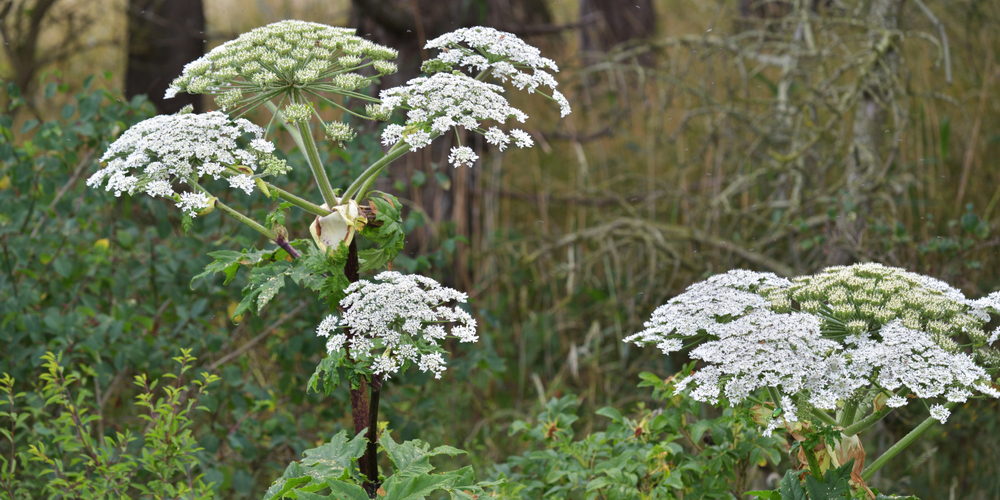Giant Hogweed, known by its scientific name of Heracleum mantegazzianum, is an invasive herbaceous plant related to the carrot family growing in the United States. It grows in many states like Connecticut, Illinois, Maine, Massachusetts, Michigan, New York, Oregon, Pennsylvania, Vermont, Virginia, and Washington.
What Is Giant Hogweed?

Growing between ten and fourteen feet and closely resembling the innocuous Queen Anne’s Lace, the Giant Hogweed plant’s attractive and innocent looks can be deceiving. It is a problematic species that can pose significant health risks. Giant Hogweed is so dangerous that in 2000, the United States Department of Agriculture added it to the Noxious Weeds List.
To avoid potential bodily harm, citizens throughout Pennsylvania should be aware and persistently on the lookout for this devious plant.
A Growing Problem in Pennsylvania
In 1985, the Pennsylvania Department of Agriculture found a significant increase in Giant Hogweed plants throughout the state. In 1998, the PDA and USDA/APHIS joined forces to create the Giant Hogweed Control Program, which worked to spread brochures statewide to warn residents of its potential health risks.
In addition, the Giant Hogweed Hotline exists to allow citizens throughout the state to report any findings of Giant Hogweed. Since the program began, over 500 sites with the plant have been reported in Pennsylvania.
What Risk Does Giant Hogweed Pose to Humans?
Giant Hogweed poses a significant risk to humans because it is capable of causing blindness and third-degree burns in extreme cases of exposure to the plant. The plant creates a toxic sap that is extremely dangerous to humans, causing burns. These burns can appear on the skin between fifteen minutes and forty-eight hours after exposure to Giant Hogweed sap. They commonly present as painful lesions and blisters that can cause skin redness and swelling.
Additionally, when exposed to Giant Hogweed juice, moist skin can develop red spots that can later turn into purple or brown scars that may last for several years after exposure. Though painless, these scars can appear embarrassing and unsightly.
Blindness is perhaps the most dangerous reaction caused by this insidious weed. If the plant’s sap is accidentally in contact with the eyes, temporary or permanent blindness is possible. Anyone who has found themselves exposed to Giant Hogweed should seek medical treatment as soon as possible to avoid these health risks.
Identifying Giant Hogweed
Giant Hogweed usually begins sprouting up in May and can be seen until August. It grows primarily in cool, moist environments such as empty lots, riverbanks, roadsides, and meadows.
The plant is identifiable by its long stems, which are hollow and covered in tiny white hairs beginning at the base of its stalks. It’s also recognizable by its characteristic large, white flowers that grow in clusters along the stems.
It is easily confused with the harmless Daucus carota, colloquially known as Queen Anne’s Lace, because of their similar-appearing white flowers. However, Giant Hogweed is larger than its innocent doppelganger, measuring between 10 and 14 feet at full height.
Other plants often confused for Giant Hogweed include Cow Parsnip (Heracleum lanatum), Angelica (Angelica atropurpurea), and Poison Hemlock (Conium maculatum).
How To Prevent the Spread of Giant Hogweed in Pennsylvania
Cutting or mowing Giant Hogweed is not recommended, as the plant has a root system that can remain dormant even after removing the visible part of the plant. This creates the problem of the plant regrowing in the same place. Removal via these methods can also make contact with the toxic sap likely and thus should be avoided.
Instead, the PA Department of Agriculture Bureau of Plant Industry has requested that anyone who discovers what they believe to be Giant Hogweed within PA to report it to the Noxious Weed Hotline at 1-877-464-9333.
If found to be Giant Hogweed, PDA staff will immediately dispatch a team to the site to apply the proper herbicides needed to prevent regrowth in the area. Reporting is essential to preventing the further spread of Giant Hogweed throughout the state.
In Conclusion
Giant Hogweed is a noxious plant that should not be taken lightly. Avoid contact with the plant and take the correct steps to remove it. Report Giant Hogweed growth to the PDA for help with correctly removing the plant.
